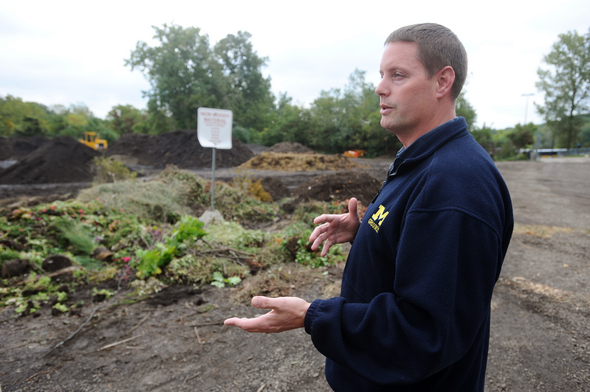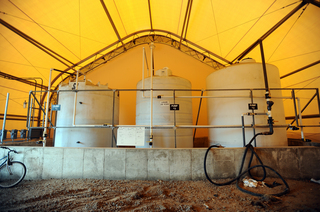University of Michigan looks to composting and chemical use as it targets sustainability

Rob Doletzky, U-M grounds services supervisor, describes composting processes while at the composting site at Plant Building and Grounds Services on Thursday
Melanie Maxwell I AnnArbor.com
On an overcast afternoon at the University of Michigan’s North Campus, the mound of soil Rob Doletzky points toward is more than twice his height.
Last year, the mound was a giant mass of leaves, weeds, flowers and dirt.
Now it’s becoming compost.
But to Doletzky, who has worked on the grounds service team at U-M for 17 years, it’s even more than compost: It’s an answer.
The compost will be mixed with water and steeped in molasses and fish remains for 24 hours in a process that pulls all the beneficial organisms out of the organic matter, creating a mixture called "compost tea" that can be sprayed on school grounds and used as a fertilizer.
The compost tea is a key strategy in the university’s push to become more sustainable and reduce the amount of chemicals applied to university grounds by 40 percent by 2025.
With 3,000 acres comprising the Ann Arbor campus, the university actively maintains 733 acres of lawn and manicured trees and shrubs. Another 584 acres are home to buildings, parking lots, streets and sidewalks, while an additional 1,754 acres are natural and not maintained.
How U-M maintains that property - and chooses the chemicals it applies to it - has a major effect on Ann Arbor's environment, including the the Huron River. It's one element of U-M President Mary Sue Coleman's plan to increase sustainability initiatives on campus, which she announced in late September.
“To protect the Huron River, a beloved natural feature of our community, we will apply 40 percent less chemicals to our trees, grass and walkways,” she said.
The compost effort started this spring. Doletzky applied the soil to four places, some with good soil and high sun exposure and others with muddier, less healthy soil and less sun. In October, Doletzky and his team plan to evaluate the compost tea to see how well it’s working.
“Once we know where we can use it we’ll expand the project, and that’s when we’re going to see a bigger drop in chemical usage,” Doletzky said.
However, university officials are anticipating the compost mixture won’t have the strength to improve soil that is already unhealthy.
“It’s an excellent fertilizer, but if you already have a very poor soil structure, the compost tea is not going to help improve your soil,” said Terry Alexander, director of U-M's Office for Campus Sustainability.
To supplement the compost mixture, the university is also exploring purchasing “more natural,” and more expensive, chemical products.
And in some situations where soil is unhealthy or heavily traveled, applying herbicides and chemical fertilizers is unavoidable. The Diag, which is commonly considered one of the hallmarks of campus life at U-M, is one of those places. For it to look pristine, it needs to be carefully maintained, Doletzky said.
“If we do use chemicals, it’s only to keep things thriving enough so we don’t have to use more chemicals,” Doletzky said. “We keep it thick so weeds don’t encroach.”
Thick grasses also increase water absorption and decrease environmentally dangerous stormwater run-off, Doletzky said.
But a 40 percent reduction is significant, and to achieve the goal U-M might have to sacrifice aesthetically. In other words, campus could look a little less pristine in 2025.
“For us to obtain the 40 percent reduction, we may have to look at what our standard level of maintenance is.,” Doletzky explained. “We may have to look at reducing at what the aesthetics of the lawn may be.”
In addition to composting, U-M is also looking to reduce the amount of salt it lays during snowfalls.
Most de-icing materials contain salt, which is harmful to local water bodies, such as the Huron River. Because surfaces where salt is applied are impervious, the salt mixtures are likely to become stormwater that could possibly run-off into the Huron, damaging the river’s integrity.
In areas that are relatively far from North Campus, salts pose a distant threat to the river. But salts absorbed into stormwater on or near “central campus, especially around the hospital, go directly to the river,” Doletzky explained
When salts or chemical fertilizers and herbicides find their way into ground water, it is not unlikely that they’ll be washed into local surface waters during a heavy rain.
With especially rainy conditions this year, the river is at unusually high-risk.
“In our rainfall pattern, we’re getting these really intense storms,” says Laura Rubin, executive director of the Huron River Watershed Council. “With the kind of storms that we’re getting we we’re seeing that we need to manage our stormwater more carefully.”
To reduce salt levels, the university currently uses a de-icing mixture that comprising a mixture of salt and corn byproduct. However, corn byproduct only makes up about 10 percent of the mixture. If the university is going to reduce it’s harmful chemicals by 40 percent, Doletzky says that the grounds service is “going to have to look in places we’ve never looked before.”
In the past 15 years, the university has decreased its salt applications by 42 percent.
Nonetheless, application remains high.
U-M applies salt to paved surfaces when there is a 50 percent probability of snowfall. In 2009-2010, U-M applied 1,927 tons of salt to its paved surfaces, which equates to 49 pounds per student, staff and faculty at the university, according to a report from the Campus Sustainability Integrated Assessment.

U-M grounds services uses a mixture of salt brine and concentrated magnesium chloride brine blended with an engineered agricultural byproduct for deicing.
Melanie Maxwell I AnnArbor.com
Out of that amount, only 167 tons included environmentally friendly alternatives, according to a recent stormwater report composed by the university.
According to Matt Naud, the city of Ann Arbor’s environmental coordinator, salt alternatives are expensive.
“With use of alternatives there’s going to be costs associated with that,” he said.
Nuad said a key issue when considering snow removal is the conflict between safe roads, a health environment and the bottom line.
Aside from reducing chemicals, a key way to protect the Huron River is to reduce the amount of stormwater that funnels into the river. During her speech, Coleman pledged to reduce run-off by 30 percent by 2025.
To achieve the reduction goal, Doletzky says the school and city not only need to install more detention bases near the river and on properties adjacent to the river, but it also needs to create more retention systems on campus.
In its current efforts to combat run-off, U-M is integrating green roofs on newly built buildings, such as the new business school building and the new children’s hospital, and has installed aqua surfaces — brick surfaces with large pores that allow water to drain into a stormwater basin— between the Rackham and North Quad buildings and between the Dana and CC Little buildings.
Rubin said the university —with nearly 600 acres of hard surfaces— is a major player contributing to the chemical run-off damaging the Huron.
“It’s in an urban area and they have significant contributions to the stormwater systems,” Rubin said.
Kellie Woodhouse covers higher education for AnnArbor.com. Reach her at kelliewoodhouse@annarbor.com or 734-623-4602 and follow her on twitter.


Comments
KJMClark
Mon, Oct 10, 2011 : 12:40 p.m.
Dang, I completely missed this on the on-line edition. Teach me to rely on the daily email. "It's an excellent fertilizer, but if you already have a very poor soil structure, the compost tea is not going to help improve your soil," said Terry Alexander. Um, compost tea isn't really a fertilizer - in the sense of something that adds NPK or minerals. It's an inoculant. The point of it *is* to improve poor soil structure. Compost tea re-inoculates the soil with aerobic bacteria and fungi. Those, together with organic matter, worms, and other organisms work to form humus. Compost tea won't do it by itself - the microorganisms have to have organic matter to break down - but it helps a lot to have a good flora to get good decomposition.
Ron Granger
Mon, Oct 3, 2011 : 6:50 p.m.
If only the University could find a way to recycle students' "spent" beer. That'd be worth trillions.
Eric
Mon, Oct 3, 2011 : 5:43 p.m.
I second that, thank you for the comprehensive and practical coverage of this subject!
Tesla
Mon, Oct 3, 2011 : 2:07 p.m.
Ms. Woodhouse. That was a very well written informative article. Nicely done.
Smart Logic
Mon, Oct 3, 2011 : 10:50 a.m.
Glad to see the university taking a stance with this and hope they continue with practical measures. Taking away trays in the cafeteria is a bit far fetched, but composting to help with the grounds is a great idea.